Tom's Guide Verdict
Deathloop makes the most of its creative time loop mechanics and tight gameplay, but the repetition can wear thin after a while.
Pros
- +
Innovative premise
- +
Tight shooting and stealth
- +
Something new in every run
Cons
- -
Repetition sets in after a while
- -
More punishing than it needs to be
- -
Stability issues
Why you can trust Tom's Guide
Deathloop is easily the most ambitious game that Arkane Studios has ever developed. Whether it’s Arkane’s best game, on the other hand, depends on what you want out of the experience. Unlike Arkane’s Dishonored series, Deathloop isn’t a demanding stealth game set in a lovingly crafted fantasy world. Instead, it’s a fast-paced, innovative and sometimes messy shooter set in a time loop on a remote northern island in the real world. It’s also unlike any other big-budget game that’s come out this year.
The premise of Deathloop is deceptively simple. Amnesiac gunman Colt is trapped in a day-long time loop, hounded by an assassin named Julianna. To break the loop, he needs to defeat Julianna and seven other major enemies, called Visionaries, in a single day. That means he’ll go through the loop again and again, uncovering the secrets of the mysterious Blackreef Island, collecting gear and upgrades, and gunning down a whole lot of cannon fodder enemies who get in his way.
It’s easy to admire Deathloop for its creative premise, tight gameplay and interactive story. As the game goes on, however, it’s also easy to see the cracks around the edges — namely repetitive runs, punishing encounters and performance issues. Still, on the whole, Deathloop is a breath of fresh air in a sea of same-y game ideas, and that alone makes it worth checking out. Read on for our full Deathloop review.
Deathloop review: Gameplay
While Deathloop is a complex game, the core concept is amazingly simple: kill eight bosses in a single run. Of course, simple doesn’t necessarily mean “easy,” as Deathloop gives you a ton of tools at your disposal to accomplish this.

You play as Colt: a man who has no memory of his past, save that he’s apparently been hunted (and killed) over and over again by a short-tempered woman named Julianna. Each time Colt dies, he reawakens on a beach on Blackreef Island: a remote scientific outpost that looks like it came out of a ‘60s spy thriller. Colt learns that Blackreef Island is stuck reliving the same day again and again, but that only he and Julianna retain their memories between each iteration. Eight brilliant “Visionaries” maintain the time loop, and killing them all in the same day is the only way to end the cycle.
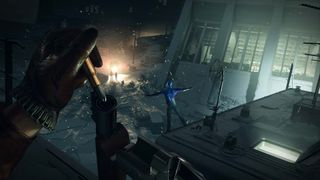
Arkane calls Deathloop a “murder puzzle,” and after your first few runs, you’ll see why. While Deathloop is, at its core, a first-person shooter/stealth game, the structure is more interesting than the moment-to-moment gameplay. Blackreef Island has four explorable districts, and four distinct times of day. Each time you leave a district, time advances.
As such, it’s not possible to simply run up to every Visionary, guns blazing, and break the time loop in a single go. Instead, you’ll have to thoroughly investigate each district, at each time of day, looking for clues about how the Visionaries spend their time, and — most importantly — when they get together. How you tackle them is ultimately up to you, whether it’s via open combat, stealth or some kind of ironic, contextual punishment. (That element from Arkane’s Dishonored series is still present, at least.)
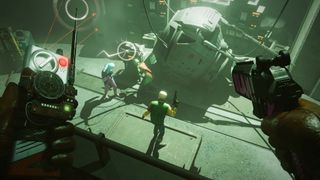
Deathloop does a fantastic job of giving you just enough information to get you started, then letting you explore the large, detailed levels for yourself. For example: One visionary, a game designer named Charlie, sequesters himself away in a mountain fortress that doubles as a live-action roleplaying game. The game simply tells you where the fortress is. It’s up to you to find a path through the enemy-laden streets, then decide whether to blast your way through the sci-fi-themed game, or take the long way around and unearth hidden entrances as you go. Once you figure out Charlie’s schedule, you can attempt to dispatch him to earn new gear, or you can leave him in peace and reserve your resources for another run. Deathloop’s open-ended design treads a perfect line between “hand-holding” and “aimless.”
Deathloop review: Combat and multiplayer
In terms of gameplay, Deathloop is a bit more action-packed than Dishonored, but a lot of the same DNA is present. You can still crouch and sneak, dispatching some enemies silently and avoiding others entirely. However, this time around, you can also employ a whole arsenal of guns, from high-caliber sniper rifles to rapid-firing machine pistols. Each gun has a rarity level, and some have special abilities; you generally get the best ones from killing the Visionaries.
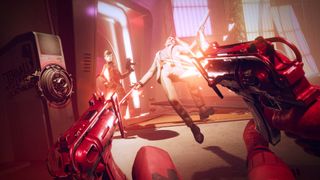
As in Dishonored, you can also equip various trinkets to bolster your abilities (more health, quieter sneaking, etc.) and your weapons (larger magazines, faster reloads, etc.). You can also outfit yourself with special powers that the Visionaries drop upon defeat, from short-range teleportation to tossing enemies around like ragdolls. The powers help streamline the game a lot, and provide a satisfying reason to confront Visionaries over and over, as they can also drop upgrades. An easy-to-earn resource called Residuum lets you keep your favorite weapons, trinkets and abilities as you repeat the loop.
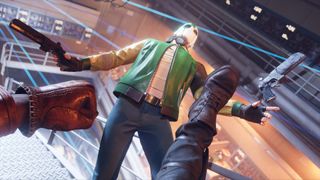
While Deathloop’s structure and mechanics make the game compulsively playable for a while, however, your advancement slows down considerably over time. During your first trip through an area, you’ll find clues, unlockable paths and world-building collectibles left and right. As you start to play the same areas over and over, however (and you will have to do this quite a bit), it all starts to feel a little rote.
You’ll have to fight the same enemies, in the same places, redoing the same puzzles and collecting the same equipment. This can feel especially punishing on paths with a lot of unavoidable enemies, or when trying to complete objectives that require absolute, unbroken stealth. Having to trudge all the way to the exit and restart the process from scratch is tiresome once, and absolutely exhausting by the fourth or fifth time.
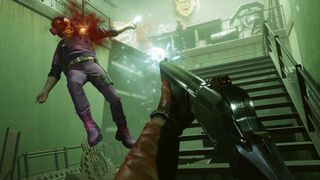
It’s also worth mentioning Deathloop’s creative multiplayer mode, in which you take control of Julianna and invade other players’ games. Doing so helps you earn cosmetics for both Julianna and Colt. It’s a creative take on PvP combat, and can create some intense, unexpected firefights. It’s also totally optional, however. You can set your game to “friends-only” invasions, which means you’ll face off only against people you know. Or you can set your game to single-player mode, which pits you against a computer-controlled Julianna.
Deathloop review: Story
The very first thing you’ll see in Deathloop is a beautiful assassin plunging a machete into your chest and acting as though the whole sordid affair is somehow your fault. It’s kind of unsettling and kind of funny, which is pretty much the tone you can expect from the rest of the game.

What works best about Deathloop’s story is just how organically it emerges. There aren’t any long cutscenes to sit through, and you don’t need to hunt down every piece of optional lore to get the full story. You’ll piece together Deathloop’s narrative at your own pace as you meet the Visionaries, track their movements and learn about how they relate to one another. There’s no special order you have to do this in, which means you’ll probably learn a little more about the plot with each new run.
The only issue with this approach is that some of the plot points are more impactful than others, and you might wind up unearthing the really juicy stuff early on in the game. Once you know exactly how Blackreef Island’s time loop started and why Julianna wants you dead, the rest of the story feels a bit like mopping up.
Deathloop review: Visuals and sound
While Blackreef Island can be a bleak place, Deathloop is a pretty game. Each of the four explorable districts has something unique to offer, from the vivacious city streets of Updaam to the lonely shorelines of Karl’s Bay. The whole game has a slightly cartoonish aesthetic and a powerful ‘60s vibe, replete with minicom computers, retro-futurist rockets and polka dot mini dresses. On a PC, you can crank the settings as high as your machine allows; on a PS5, you can run at dynamic 4K resolution or a steady 60 frames per second.
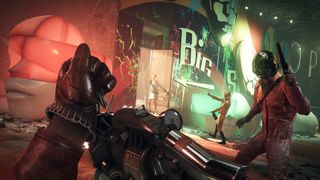
The game’s music and voicework are also stellar, with plenty of ambient tunes and a lot of spirited banter. Jason E. Kelley as Colt and Ozioma Akagha as Julianna really steal the show, however, with frequent back-and-forths that can turn from good-natured to vindictive on a dime. Since the two of them can (and do) kill each other frequently, there’s no impending confrontation hanging over their exchanges. Every conversation has a laid-back, mildly threatening vibe that’s sometimes playful and sometimes laugh-out-loud funny.
The only big issue here is that Deathloop is not very stable on PC. The game crashes regularly enough to be an issue, and frequently drops frame rates, even when there’s nothing particularly demanding going on. Bethesda is working on a patch for these issues, but crashes present a real problem, as the game saves only between areas.
Deathloop review: Verdict
Play Deathloop long enough, and the shine wears off a bit. A time loop is, by nature, a repetitive event, and the game can’t quite square that with its “make progress in every run” philosophy. Some runs are complete wastes of time, and that’s particularly frustrating when you need to replay a particularly difficult or demanding section.
On the other hand, Deathloop takes a creative premise and delivers on it extremely well. There’s a ton to do and see, and you can do it and see it at your own pace, in your own playstyle. The hero and villain share a delightful chemistry, and once you learn the ins and outs of the loop, you’ll start to feel pretty clever.
If nothing else, we haven’t seen a game quite like Deathloop before. That alone arguably makes it worth a look.
Marshall Honorof is a senior editor for Tom's Guide, overseeing the site's coverage of gaming hardware and software. He comes from a science writing background, having studied paleomammalogy, biological anthropology, and the history of science and technology. After hours, you can find him practicing taekwondo or doing deep dives on classic sci-fi.

